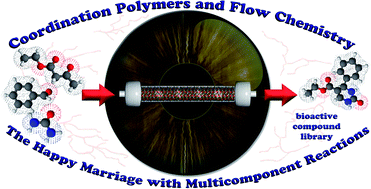The Biginelli reaction under batch and continuous flow conditions: catalysis, mechanism and antitumoral activity†
Abstract
Two novel coordination polymers (CPs) have been synthesized, characterized and successfully applied as robust heterogeneous catalysts for the Biginelli multicomponent reaction to obtain 3,4-dihydropyrimidin-2(1H)-one or thione (DHPMs) derivatives. The reaction was initially developed using both CPs and the Zn-based material showed much better catalytic activity. After the reaction optimization under batch conditions, a continuous flow protocol was developed and applied with impressive results. Four bioactive DHPMs were successfully synthesized with high yields. The mechanism of the transformation was also investigated by electrospray (tandem) mass spectrometry (ESI-MS(/MS)) analyses. Online monitoring of the reaction indicated under the developed conditions that the iminium mechanism is preferred over the enamine- and Knoevenagel-based mechanisms. Nine DHPMs had their antitumoral activities evaluated against MCF-7 (human breast cancer cells), A549 (human alveolar basal epithelial cells) and Caco-2 (human epithelial colorectal cells) cancer cell lineages. Fibroblasts (healthy cells) were not affected by the tested DHPMs showing an excellent selectivity for tumour cells. Three DHPMs returned impressive results, being capable of inhibiting tumour cell proliferation in 72 h.


 Please wait while we load your content...
Please wait while we load your content...